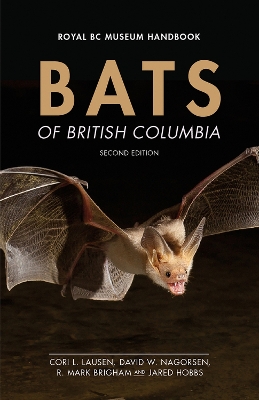Reviewed by annieb123 on
Bats of British Columbia is a beautifully illustrated comprehensive field guide to the bat species of British Columbia. Originally published in 1993, this second edition is due out 25th March 2022 from The Royal BC Museum. It's 384 pages and will be available in paperback and ebook formats.
I love field guides. I don't do a whole lot of hiking around in inaccessible wild places and cataloguing the flora and fauna, but I still love flipping through field guides and reading about the animals and plants they contain. This is a well written and accessible field guide, full of facts and high resolution photographs of bats.
The book is logically arranged so that information is easily accessible: an introduction with basic taxonomy and physiology is followed by a handy checklist of species endemic to BC. The following sections cover general bat behavior and characteristics, conservation, threats, reproduction, diseases, and other general concerns. The authors have included a short section on ID, both in-hand and by echolocation/acoustics.
The following chapters contain accounts of specific species and data collected from transmitter tagged bats which include data on migration, torpor, taxonomy, measurements (where available), and comments from the field biologists (generally the authors). The species photographs are amazingly well done, in colour and high definition. I received an electronic copy of the book for review and the photographs were not pixelated or grainy in the slightest. Accidental, non-endemic species are discussed separately and specified as such.
The appendices are worthwhile and information rich: additional species referred to elsewhere in the text, skull and odontological identification, species morphology tables, acoustic species summaries, and (my favourite) fun bat facts. The book is well annotated throughout, and the bibliography and chapter note references will provide keen readers with lots of potential sources for further reading. Much of the behavioural data related here is written from field collected data and is fascinating for laypersons as well as more rigorous students of natural science. Technical terms are defined in the text and included in a glossary at the back of the book. One stylistic detail which I liked was listing species in the text in smaller point all caps to keep them easy to see; a technique that works very well.
Five stars. This is a very good and very interesting factual book on bats. This would be a superlative choice for public or school library acquisition as well as for the home library. There are a number of references and photos of scientific field experiments shown in the book which will be enlightening and fun for lab sciences teachers to show their students (this is the kind of fun stuff scientists get to do).
Disclosure: I received an ARC at no cost from the author/publisher for review purposes.
Reading updates
- Started reading
- 12 March, 2022: Finished reading
- 12 March, 2022: Reviewed
